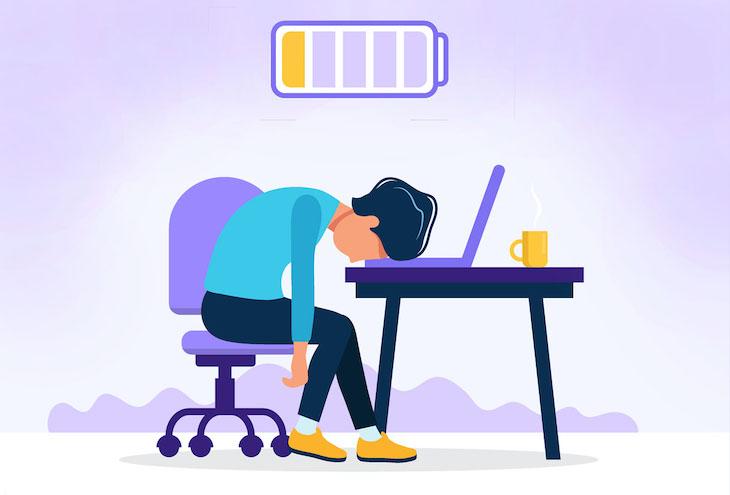So here we are — almost a year into a pandemic — with lives full of virtual activities we used to do in person. We’ve adjusted in countless ways to keep ourselves and our loved ones safe. Whether you’re learning online entirely or have a “blended” schedule of physical classroom and distance learning, It isn’t easy. A reality of our brave new world is “virtual burnout.”
Yep, it’s a thing, and there is psychology behind it. According to the results of new research from a University of Kansas professor, video calls require more mental processing than face-to-face meetings. The research also found that onscreen discussions require higher energy use and involve more stress than other modes of communication, including face-to-face, email, and phone. So if you’re feeling some “Zoom fatigue,” it’s understandable. But take heart! It’s possible to turn things around.
Treat it like an in-person class
Make your virtual education a top priority, just as you would attending school in a physical classroom. Do your best to approach it with discipline. “Without the regular meetings of in-person classes, it’s easy to fall into bad habits and get behind on your work,” observes Ransom Patterson, editor in chief at CollegeInfoGeek.com. “To avoid this,” he continues, “treat online classes like in-person classes.”
It’s important to get dressed and ready for your remote classes the way you would for courses in person. Arrive prepared with reading and other homework completed and be sure to have any required books or classroom supplies handy. Your instructors are making a big effort to keep you and your classmates engaged, so give them a chance.
Focus and avoid distractions
Keep your learning-from-home space organized and free of potential distractions. Be sure your family members or housemates know your schedule so they don’t accidentally interrupt your class time. “Your study space can be anywhere that helps you focus,” advises Patterson. “My only word of warning is to avoid somewhere that’s too comfortable or distracting. Don’t study sitting in bed or next to your game system. Find a place that signals ‘it’s time to work.’”
While being a student means you have a number of responsibilities, dividing your attention to get things done can be counterproductive. “Multitasking is less productive than focusing on a single task at a time,” notes Coursera’s Linlin Xia. “Researchers from Stanford University found that ‘people who are regularly bombarded with several streams of electronic information cannot pay attention, recall information, or switch from one job to another as well as those who complete one task at a time.’”
Take notes
Regular note taking is a great habit that can increase learning and retention. In addition to helping you keep track of information and assignments, taking notes can help you remember key points and organize your thoughts. “The real benefit of taking notes is that it helps you engage with the material and put it in your own words,” says Patterson.
There are other benefits too. “Taking notes can promote active thinking, boost comprehension, and extend your attention span,” explains Xia. “It’s a good strategy to internalize knowledge whether you’re learning online or in the classroom.” Even if you find yourself engaging in the occasional doodle, that’s okay. Research shows that doodling during class time can keep the brain active and on task.
Pace yourself and ask for help when you need it
Distance learning requires patience and endurance, so take short breaks. Simply standing up to stretch your arms and legs will increase blood flow and circulation to your muscles and brain. If you need to focus on something non-academic between classes or tasks, go ahead — but don’t overdo it. "Resting your brain after learning is critical to high performance,” points out Patterson. “If you find yourself working on a challenging problem without much progress for an hour, take a break."
If you’re having a hard time with a concept or struggling to make sense of new information, ask for help. See if you can schedule one-on-one time with a teacher in an online breakout room or on the phone. Getting individual attention can also be a good way to feel more connected during these times when so many of us have to stay apart. While remote learning can have its challenges, you can overcome them and make your virtual education a success.
 On Topic
On Topic
Jacob Calderone, Cree, is the AISES Senior Canadian National Student Representative. A third-year biochemical engineering student at Queen's University in Kingston, Ontario, he hails from Fort Nelson First Nation in Northern British Columbia.
After months of learning remotely, how likely is virtual burnout?
Extremely likely. Students like me have been on our computers for most if not all of the day, seven days a week. Between online lectures, team meetings, extracurricular events, and video chats with family and friends, we’re living our lives virtually. As with any repeated activity that requires substantial time and effort, burnout is a distinct possibility.
What are the top three signs of virtual burnout?
The first major sign that I have experienced is feeling guilty for not being productive. All I need to do my work is to simply open the laptop, so in theory I have the ability to work all day. This is obviously not healthy for the body or the mind. Despite this, I sometimes feel guilty for taking breaks and having some downtime because instead of the rest, I could be doing work.
The second sign of virtual burnout is lack of energy. If you’re feeling lethargic and don’t want to eat or go outside for some fresh air, you’re likely experiencing burnout.
The third sign is the inability to sleep soundly. If you are having difficulty sleeping, it’s probably due to too much remote work and not enough breaks.
What are some steps that can reverse burnout?
If you’re experiencing virtual burnout, self-care is important. This can be in the form of meditation, a quick walk outside, reading a book, or even video chatting with friends and family. The most important thing to do if you’re experiencing burnout is to carve out downtime during the day and make sure you are well hydrated and getting quality rest each night.
Why is it important to find outlets away from electronic devices?
Finding no-tech outlets allows your brain to experience something other than a screen. Going outside for a breath of fresh air and having the sun hit your face is important. Time outside is just one way to escape the stress and anxiety of virtual learning.
What resources do you recommend for students trying to counter virtual burnout?
Creating a daily schedule can help. I use Google Calendar to organize my day and keep me in a routine. In my schedule, I block off times for taking a break. Other resources include meditation and exercise. There are various online resources that offer tips and instructional videos on how to relax and ease your body and mind. Also, students can reach out to their schools’ student services departments. Many schools offer workshops on healthy living and academic counselors to help adjust to remote learning.














